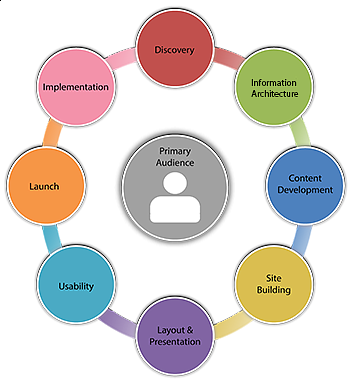User Experience
If the web is the university's digital front door, then a user-centered approach defines how we treat our guests. The UO-branded elements are designed to provide maximum utility for various audiences visiting UO websites while maintaining a consistent experience across sites.
First and foremost, focus on your audiences and their primary needs. Then create your content to serve those needs. For example, you might focus on the services your unit provides instead of an organizational chart. In most cases, users visit your website in search of answers, and most often, those answers are more easily found when a website is structured around what you do rather than to whom you report.
Leverage the strength of the University of Oregon’s reputation when building your site. Rather than attempting to create a branded identity for your department or a custom web design from scratch, use the resources on this site to provide your users with an effective website that is also within the established identity of the university.
By using the existing UO-branded website resources, you can focus your efforts primarily on your serving your audiences with excellent and usable web content.
There are many ways to begin to focus on user experience. Browse through the pages in this section to learn more about the user-centered process or you can also start with Steve Krug's great book: Don't Make Me Think: A Common Sense Approach to Web Usability, which is available in UO Libraries.
The User-Centered Process
The user-centered design process seeks to engage end-users in all stages of design and development. From understanding requirements to testing out designs, you will work with your users and stakeholders to find answers to the following questions:
- Who is your primary target audience?
- Why are they visiting your website? What are they trying to accomplish?
- How do their environment, attitudes, and prior experiences impact their expectations of your site?
- How do users refer to and think about your content?
A deep understanding of your end users’ needs will enable you to make strategic, data-driven decisions about your website content, navigation, and design.
What’s involved in the user-centered design process?

While each project is unique, a user-centered design process follows these basic phases:
- Discovery – During the discovery phase, you seek to understand what both your end-users and your department requires for success.
- Information Architecture – This phase focuses on creating and testing effective and engaging content structure and site navigation to support user and departmental needs.
- Content Development – The focus is on developing content to support your end-users needs and organizational objectives.
- Site Building – A staging site is for your team to input and test content before launch.
- Layout & Presentation – UO websites provide standard design elements to support your content, messaging and user tasks.
- Usability – Leading usability studies with end users to help identify last-minute improvements to ensure that your site is effective, engaging and easy to use.
- Launch - Your website is live.
- Implementation – After site launch, your focus shifts to validating usability and measuring outcomes.
